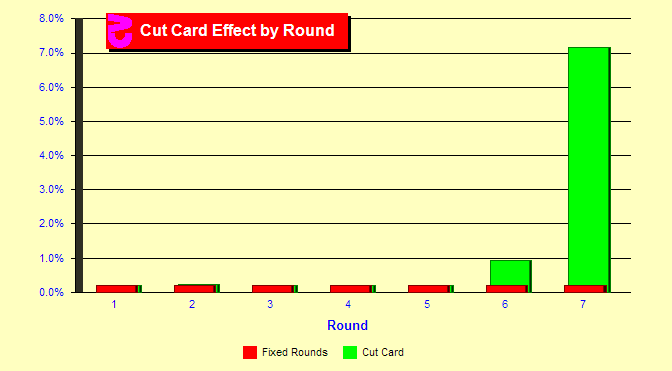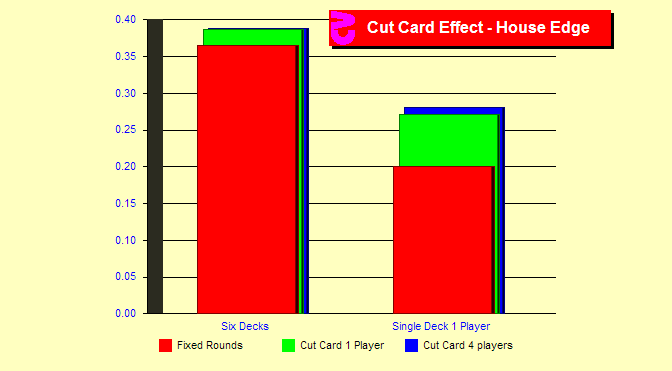|
|
Chapter 11. Unusual Effects
| This chapter takes some time out to take a quick look at oddities
of Blackjack that affect us even though we largely ignore them.
"Are you real or not? It's a fine line." —
Warren Zevon, 1994
| |
 What
is the effect of the cut card? What
is the effect of the cut card?
Some single-deck games and nearly all hand-dealt shoe games deal
to a specified point and then shuffle after the current round ends.
Some single-deck games deal a fixed number of rounds depending on
the number of players. The cut-card effect is the effect on advantage
caused by dealing to a fixed point instead of a fixed number of
rounds.
This chart compares using a cut card with dealing a fixed number
of rounds in a standard single-deck game with one player using Basic
Strategy. The red bars show an even 0.2% advantage for the casino
for all hand depths when dealing a fixed number of rounds. The green
bars show the enormous increase in the casino's advantage in the
late rounds when dealing with a cut card. There is a reason for
this difference related to card counting even for a Basic Strategy
player. In this set of circumstances, if you deal to a cut card
you may get five, six or seven rounds depending on the cards. This
is because the player and dealer can have hands of two cards or
many cards. If there are many high cards (e.g. tens) dealt, we will
end up with two- and three-card hands. If there are small cards
dealt, we will end up with hands with many cards. So, if we are
dealing to a fixed point, and we are dealt a lot of large cards,
then we will use fewer cards per round and get an extra round or
two. The problem is that these extra rounds will be dealt from a
deck with fewer high cards because they have been used up. And we
know that a deck with few high cards left is bad for the player.
|
 What
is the overall effect? What
is the overall effect?
Now the overall effect is not quite as bad because there aren't
as many rounds played at these terrible disadvantages. But there
is an effect. This chart shows the difference between a fixed number
of rounds and using a cut card. I have included a six-deck game
even though six decks is not normally played to a fixed number of
rounds. Although it is in most Internet casinos and some Video Blackjack
machines. Here we see the overall differences in house edge between
cut card and fixed rounds. Note that in single-deck the numbers
can change substantially by the exact circumstances, including when
the specific dealer chooses to shuffle without a fixed-round rule.
Of course, all that I've shown with all of the above is what was
already known. The cut-card adds hands when the deck is lean in
tens. So, does this mean that you should avoid single-deck using
a cut-card? Probably yes, if you're playing Basic Strategy. But,
if you're counting, the effect is minor. Counting cards partially
corrects for the effect.
Oddly, it is interesting that all the sources for Basic Strategy
house edge ignore this effect even though it exists for the vast
majority of games.
|
Sim details
- Six decks, S17, DAS, LS, 1 player, Basic Strategy
- Single-deck, H17, 1 & 4 players, Basic Strategy
- Six decks ten billion rounds, Single-deck five billion rounds
|
|
|
 What
is the effect of the cut card?
What
is the effect of the cut card? What
is the overall effect?
What
is the overall effect?